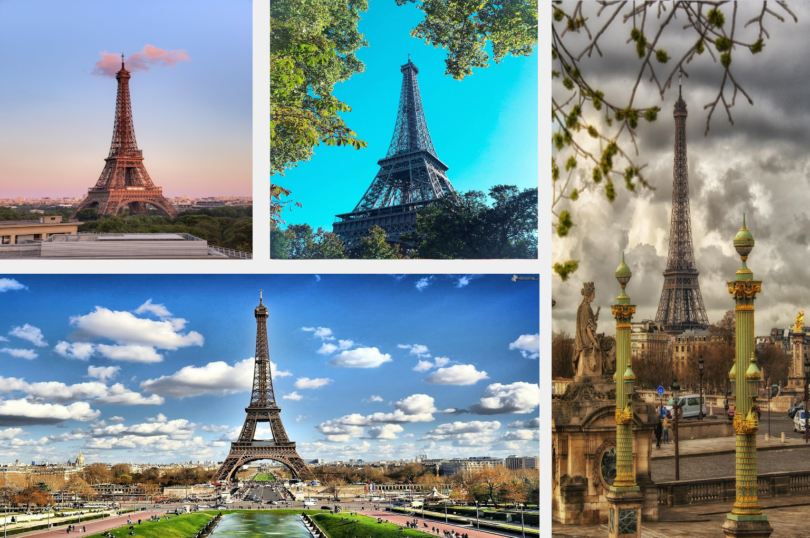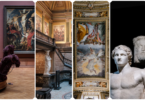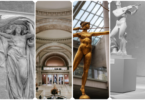Paris, the City of Love, is known for its charm, beauty, and iconic landmarks. Among these landmarks, the Eiffel Tower stands tall, capturing the hearts and imaginations of visitors from around the world. As you explore Paris, a visit to the Eiffel Tower is an absolute must.
The Eiffel Tower, also known as La Tour Eiffel in French, is not just a structure but a symbol of Paris itself. This magnificent iron lattice tower has a rich history, cultural significance, and an unparalleled view that will leave you in awe.
Standing at an impressive height of 330 meters (1,080 feet), the Eiffel Tower dominates the Parisian skyline. Its location in the heart of the city provides a perfect vantage point to take in the beauty of the surrounding landscape. From the top, you can see the sprawling cityscape, the picturesque River Seine, and other famous landmarks like the Notre-Dame Cathedral and the Louvre Museum.
Visiting the Eiffel Tower is a unique experience that offers more than just breathtaking views. It allows you to delve into the rich history and cultural impact of this iconic structure. The Eiffel Tower has witnessed significant milestones in history, including both peaceful and turbulent times, making it a symbol of resilience and endurance.
To make the most of your Eiffel Tower visit, it’s essential to plan ahead. The tower attracts millions of visitors each year, so purchasing tickets in advance is highly recommended. You can either choose to take the elevator or challenge yourself by climbing the stairs to the observation decks.
While at the Eiffel Tower, take your time to absorb the atmosphere and enjoy the surroundings. Capture beautiful photos, indulge in delicious French cuisine at one of the tower’s restaurants, or simply take a leisurely walk in the Champ de Mars park nearby.
Key Takeaways:
- The Eiffel Tower is a must-visit attraction in Paris, offering unparalleled views of the city.
- With a height of 330 meters, it dominates the Parisian skyline.
- Planning ahead and purchasing tickets in advance is recommended to avoid long queues.
- Take your time to explore the tower, enjoy the surrounding area, and capture memorable moments.
- The Eiffel Tower is not just a structure but a symbol of resilience and endurance in the face of historical moments.
Eiffel Tower Height and Location
The Eiffel Tower, one of the world’s most iconic landmarks, boasts an impressive height that draws millions of visitors each year. Located in Paris, France, this architectural marvel stands at an astonishing height of 330 meters (1,083 feet) including its antennas. Originally constructed as a temporary exhibit for the 1889 Exposition Universelle (World’s Fair), the Eiffel Tower quickly captured the hearts of people around the world and became a permanent fixture in the Parisian skyline.
Situated in the heart of the city, the Eiffel Tower offers breathtaking panoramic views of Paris from its observation decks. From the top, visitors can admire the beautiful cityscape, including famous landmarks such as the Louvre Museum, Notre-Dame Cathedral, and the River Seine.
Interesting Facts:
- The Eiffel Tower is named after its engineer, Gustave Eiffel, who also oversaw its design and construction.
- During its construction, the tower faced criticism and controversy, with some Parisians expressing their skepticism, but it has since become an enduring symbol of Paris.
- A fascinating fact about its height is that it changes depending on the weather. Due to thermal expansion, the Eiffel Tower can grow by up to 6 inches (15 centimeters) on hot days.
This grand structure attracts visitors from around the globe who come to admire its beauty, learn about its history, and enjoy the enchanting views it offers. Whether you’re standing beneath its towering presence or gazing at it from afar, the Eiffel Tower is a sight that never fails to captivate.
| Height | Location |
|---|---|
| 330 meters (1,083 feet) | Paris, France |
Eiffel Tower Tickets and Visitor Information
Planning a trip to the Eiffel Tower? Here’s everything you need to know about purchasing Eiffel Tower tickets and making the most of your visit.
How to Purchase Eiffel Tower Tickets
There are several ways to secure your Eiffel Tower tickets in advance. To save time and avoid long queues, it is recommended to book your tickets online. Tickets can be purchased directly from the official Eiffel Tower website or through reputable travel agencies. By booking in advance, you can choose a specific date and time for your visit, ensuring a smooth and hassle-free experience.
If you prefer to purchase tickets on the day of your visit, you can do so at the ticket booths located at the base of the tower. However, be prepared for potentially long queues, especially during peak tourist seasons.
Tips for a Memorable Visit
Here are some tips to help you make the most of your Eiffel Tower experience:
- Arrive early: To avoid large crowds and enjoy a more tranquil visit, try to arrive at the Eiffel Tower early in the morning or during weekdays.
- Choose the right entrance: There are multiple entrances to the Eiffel Tower. The South Pillar (Pilier Sud) entrance is often less crowded than the East and West Pillar entrances.
- Take the stairs: If you’re up for a bit of exercise, consider taking the stairs instead of the elevator. Not only will this save you time waiting in line, but it also provides a unique perspective of the tower as you ascend.
- Consider a guided tour: For a more comprehensive insight into the Eiffel Tower’s history and architecture, consider booking a guided tour. Knowledgeable guides can enhance your experience by providing fascinating anecdotes and behind-the-scenes information.
- Enjoy the panoramic views: Once you reach the top of the tower, take the time to soak in the breathtaking panoramic views of Paris. Be sure to have your camera ready to capture the iconic landmarks that paint the cityscape.
Visitor Information
Before your visit, it’s essential to be aware of some important visitor information:
- Opening hours: The Eiffel Tower is generally open every day from morning until late evening. However, opening hours can vary depending on the season, so it’s advisable to check the official website for the most up-to-date information.
- Security measures: To ensure the safety of all visitors, security measures are in place at the Eiffel Tower. Bags and belongings are subject to inspection, and certain items may not be allowed inside the premises. It’s recommended to travel light to avoid any inconvenience.
- Accessibility: The Eiffel Tower is accessible to visitors with mobility issues. Elevators are available to take you to the different levels of the tower, and there are designated ramps and facilities to accommodate wheelchair users.
- Dining options: The Eiffel Tower offers a variety of dining options, ranging from casual cafes to elegant restaurants. If you’re looking for a special dining experience, consider making a reservation in advance.
By following these tips and being well-informed about visitor information, you can make your visit to the Eiffel Tower a truly memorable one. The Eiffel Tower tickets allow you to discover the beauty and grandeur of this iconic landmark, taking in the history, the views, and the unforgettable atmosphere.
| Opening Hours | Peak Season (June to September) | Off-Peak Season (October to May) |
|---|---|---|
| Monday – Sunday | 9:00 AM – 12:45 AM | 9:30 AM – 11:45 PM |
Eiffel Tower History and Cultural Impact
The Eiffel Tower, an iconic symbol of Paris, has a rich history that dates back to its construction in the late 19th century. Gustave Eiffel, a renowned French engineer, designed the tower as the centerpiece of the 1889 Exposition Universelle, a world’s fair held in Paris to celebrate the 100th anniversary of the French Revolution.
However, the Eiffel Tower wasn’t met with immediate acclaim. In fact, it faced significant controversy during its construction. Many Parisians considered the tower to be an eyesore and criticized its modern and unconventional design. Some even went as far as signing a petition against it.
Despite the initial backlash, the Eiffel Tower gradually won the hearts of the French people and became an enduring symbol of national pride. It symbolized France’s industrial prowess and innovation during the late 19th century.
“The Eiffel Tower is a marvel of engineering and a testament to human creativity. Its awe-inspiring design and sheer height have captivated visitors from all over the world for more than a century.”
Over time, the Eiffel Tower’s cultural impact extended beyond France. It has become a globally recognized landmark, representing not only the beauty of Paris but also the ingenuity and artistic vision of its creator, Gustave Eiffel.
As a symbol of France, the Eiffel Tower has been featured in countless movies, television shows, and works of literature. Its elegant silhouette has graced postcards and souvenir shops, becoming synonymous with the romantic charm of Paris itself.
Today, the Eiffel Tower stands as one of the most visited tourist attractions in the world, attracting millions of visitors annually. Its observation decks offer breathtaking views of the city, and its restaurants provide an unforgettable dining experience.
From its controversial beginnings to its status as a global icon, the Eiffel Tower’s history and cultural impact have solidified its place in the hearts of people worldwide. It continues to inspire awe and fascination, embodying the enduring spirit of Paris and serving as a testament to human achievement.
The Eiffel Tower’s Function and Meaning
The Eiffel Tower, with its towering presence and intricate lattice design, serves both as a functional structure and a symbol of rich meaning. Its multifaceted role has captivated the hearts and minds of people worldwide, making it an enduring icon of human achievement.
Symbolism and Interpretations
The Eiffel Tower’s symbolism goes beyond its physical beauty. It has become synonymous with Paris, representing the city’s elegance, romance, and artistic spirit. For many, the Eiffel Tower embodies the essence of France itself, standing as a proud testament to the nation’s cultural heritage.
The tower’s grace and grandeur evoke a sense of awe and wonder, inspiring artists, poets, and dreamers throughout history. Its striking silhouette against the Parisian skyline has made it a muse for countless works of art, literature, and cinema.
“The Eiffel Tower is a masterpiece of ironwork, an architectural marvel that not only dominates the landscape but also captures the imagination of all who behold it.” – Renowned Architect, Jean-Paul LaBelle
The interpretations of the Eiffel Tower’s meaning are diverse and subjective. To some, it represents progress and innovation, symbolizing the triumph of human ingenuity over the limitations of the past. Others view it as a beacon of hope and unity, reflecting the ideals of freedom, enlightenment, and cosmopolitanism.
Functionality and Practicality
Aside from its symbolic significance, the Eiffel Tower serves several practical functions. Originally constructed as the entrance arch to the 1889 World’s Fair, it was intended to commemorate the centennial of the French Revolution and showcase France’s industrial prowess.
Today, the tower functions as a premier tourist attraction, offering visitors breathtaking panoramic views of Paris from its observation decks. Its elevators transport thousands of tourists daily, providing a unique vantage point to admire the city’s iconic landmarks, such as the Notre-Dame Cathedral and the Louvre Museum.
| Function | Description |
|---|---|
| Tourism | The tower attracts millions of visitors each year, contributing to the thriving tourism industry in Paris. |
| Telecommunications | Antennas atop the tower ensure seamless communication, broadcasting radio and television signals across the region. |
| Lighting and Illumination | The Eiffel Tower serves as a dazzling beacon at night, adorned with mesmerizing light displays during special occasions and holidays. |
The Eiffel Tower’s functionality extends beyond its intended purposes. It fosters social connectivity, providing a meeting place for friends, couples, and families. It also serves as a backdrop for celebratory events, such as the annual Bastille Day fireworks display, strengthening the sense of community and shared experiences.
In the 21st century, the Eiffel Tower continues to inspire awe, spark creativity, and unite people from all walks of life. Its function and meaning have evolved with time, making it an everlasting testament to human imagination and the enduring spirit of Paris.
Construction Marvel: The Dream of Iron
When discussing the incredible structure that is the Eiffel Tower, it is impossible to overlook the immense engineering and design prowess behind its construction. The Eiffel Tower stands tall as a testament to human ingenuity and perseverance, representing an unparalleled construction marvel that has fascinated people for over a century.
At the heart of this engineering marvel was the visionary mind of Gustave Eiffel, a renowned French engineer. Eiffel’s innovative design for the tower drew both admiration and controversy, pushing the boundaries of architectural possibilities.
“I ought to be jealous of the tower. She is more famous than I am.” – Gustave Eiffel
During its construction, the Eiffel Tower faced significant challenges, not only in terms of its technical complexity but also due to public skepticism. Critics doubted the tower’s structural integrity, questioning its ability to withstand the test of time. However, Eiffel’s meticulous calculations and attention to detail silenced the skeptics, and the tower proudly stood as a triumph of human achievement.
The design of the Eiffel Tower itself is a masterpiece of intricate engineering. Its innovative use of iron, a material at the forefront of technological advancements during that era, showcased the possibilities of modern construction techniques. The tower’s lattice structure and graceful arches are not only aesthetically pleasing but also vital for its stability and strength.
Today, the Eiffel Tower continues to captivate visitors from around the globe, serving as a symbol of architectural brilliance and artistic expression. Its unique design has inspired countless structures worldwide, leaving an indelible mark on the field of architecture and design.
| Engineering Marvels of the Eiffel Tower | Architectural Innovations |
|---|---|
| 1. Efficient use of iron for strength and stability | 1. Lattice structure providing structural integrity |
| 2. Ingenious design incorporating graceful arches | 2. Artistic blend of form and function |
| 3. Precise calculations for load-bearing capacity | 3. Utilization of modern construction techniques |
The Legacy of the Eiffel Tower
The Eiffel Tower’s construction marvel is a testament to the human spirit and the limitless possibilities of architectural innovation. It stands not only as an iconic symbol of France but also as a global representation of grandeur and excellence in design. The tower’s profound influence on the world of construction and engineering continues to inspire generations, making it an enduring legacy that will be cherished for centuries to come.
The Tower’s Debut: From Controversy to Icon
When the Eiffel Tower was first unveiled to the public in 1889, it faced a wave of criticism and controversy. Many Parisians considered it an eyesore, with some even signing a petition demanding its demolition. However, over time, the towering iron structure managed to win over hearts and became an enduring icon of the city.
The Eiffel Tower in war and peace
As history unfolded, the Eiffel Tower played a significant role during both war and peace. During World War I, the tower proved its worth as a strategic communication center, intercepting enemy messages and contributing to intelligence efforts. It stood tall, providing a sense of solidarity and strength to the people of Paris during such trying times.
In the years that followed, the Eiffel Tower became a symbol of peace, representing unity and hope. It served as a backdrop for various peace rallies and events, reminding people of the need for harmony and understanding in a world often divided.
A modern icon
Today, the Eiffel Tower stands as not only a beloved landmark but also a modern icon that represents the allure and elegance of Paris. Its distinctive silhouette against the city’s skyline continues to captivate visitors from around the world, drawing millions each year.
Table: Eiffel Tower Facts
| Height | Location | Construction Duration |
|---|---|---|
| 330 meters (1,083 feet) | Paris, France | 2 years, 2 months, and 5 days |
The Eiffel Tower’s enduring legacy stems from its ability to transcend its initial controversy and gain recognition as a cherished symbol of Paris. Today, it stands tall as a testament to human innovation and the power of embracing bold and unconventional ideas.
The Eiffel Tower Today: Enduring Legacy and Reflections
In the 21st century, the Eiffel Tower continues to stand as a symbol of architectural marvel and cultural significance. Its towering presence in Paris attracts millions of visitors from around the world, making it one of the most iconic tourist destinations. The enduring legacy of the Eiffel Tower lies in its ability to capture the imagination and leave a lasting impression on anyone who beholds its majestic beauty.
Reflecting on its significance today, the Eiffel Tower serves as a testament to human creativity and engineering prowess. Standing at a staggering height of 324 meters, it showcases the brilliance of Gustave Eiffel’s design and construction. The iron lattice structure, once considered controversial during its inception, now inspires awe and admiration in the hearts of all who gaze upon it.
Beyond its physical magnificence, the Eiffel Tower represents the spirit of Paris and its vibrant culture. It serves as a backdrop for romantic moments, a gathering place for celebrations, and a symbol of national pride. From its strategic location on the Champ de Mars, the tower offers panoramic views of the city, captivating visitors with its beauty day and night.
“The Eiffel Tower is a true masterpiece of human ingenuity and a testament to the limitless possibilities of architectural design. Its silhouette against the Parisian skyline is a sight that never fails to enchant.” – Jean-Paul, a Parisian local.
In the fast-paced modern world, the Eiffel Tower remains a beacon of timeless charm and allure. Its enduring popularity stems from its ability to transcend time and connect with people of all generations. From the top levels of the tower, visitors can gaze upon the sprawling cityscape, witnessing the harmony between traditional landmarks and futuristic skyscrapers.
In recent years, the Eiffel Tower has embraced technology and innovation to enhance the visitor experience. The installation of elevators, panoramic glass floors, and interactive displays has made the ascent even more immersive and captivating. Today, visitors can indulge in virtual reality experiences that transport them back in time to the tower’s early days, or learn about the intricacies of its construction through multimedia presentations.
“Visiting the Eiffel Tower is like stepping into a living history book. Its legacy stands tall, reminding us of the vibrant past that Paris holds and the limitless possibilities that lie ahead.” – Olivia, a tourist from the United States.
The Eiffel Tower today symbolizes not only the beauty of Paris but also the resilience of the human spirit. It serves as a reminder that greatness can be achieved when dreams meet determination and creativity knows no bounds. As we look towards the future, the Eiffel Tower will continue to inspire generations, standing as an enduring testament to the power of human accomplishment.
| Key Facts about the Eiffel Tower Today | |
|---|---|
| Height: 324 meters (1,063 feet) | Location: Champ de Mars, Paris, France |
| Visitor Count: Over 7 million visitors annually | Architecture: Gustave Eiffel |
| Attractions: Elevators, glass floors, interactive displays | Significance: Iconic symbol of Paris and French culture |
Conclusion
As we conclude our exploration of the Eiffel Tower, it becomes clear why this iconic structure is a symbol not only of Paris but of the world. With its soaring height and breathtaking views, the Eiffel Tower offers visitors an unforgettable experience that combines history, culture, and architectural marvel.
From its controversial beginnings to its status as a modern-day icon, the Eiffel Tower has captured the hearts and imaginations of millions. Its enduring legacy continues to inspire awe and fascination, making it a must-visit destination for anyone venturing to Paris.
Whether you admire the tower’s engineering marvel, delve into its rich history, or simply enjoy the stunning views from its observation decks, the Eiffel Tower remains an ever-present symbol of Parisian charm and elegance. So, don’t miss the opportunity to marvel at this legendary landmark and create memories that will last a lifetime.
FAQ
What is the height of the Eiffel Tower?
The Eiffel Tower stands at a height of 330 meters (1,083 feet).
Where is the Eiffel Tower located?
The Eiffel Tower is located in Paris, France, specifically in the Champ de Mars park near the Seine River.
How can I purchase tickets to visit the Eiffel Tower?
Tickets to the Eiffel Tower can be purchased online in advance or on-site at the ticket office. It is recommended to buy tickets in advance to avoid long queues.
What should I expect during my visit to the Eiffel Tower?
During your visit to the Eiffel Tower, you can expect stunning panoramic views of Paris from the observation decks on the different levels. There are also restaurants and gift shops available for visitors.
What is the history and cultural impact of the Eiffel Tower?
The Eiffel Tower was built as the entrance arch to the 1889 World’s Fair. Despite initial controversy, it quickly became an iconic symbol of Paris and a testament to French engineering and innovation.
What is the function and meaning behind the Eiffel Tower?
The Eiffel Tower serves as a symbol of France’s cultural heritage, representing the country’s artistic and technological prowess. It also holds significance as a landmark for tourists and a monument to human achievement.
What were the design and construction challenges of the Eiffel Tower?
The Eiffel Tower was designed by engineer Gustave Eiffel and faced criticism during its construction due to its unconventional design. The main challenge was to ensure structural stability and maintain the tower’s visual elegance.
How did the Eiffel Tower become an icon?
Despite its controversial beginnings, the Eiffel Tower quickly became a beloved icon of Paris. Its role during both World Wars and its presence in countless cultural references have solidified its status as a modern symbol of France.
What is the significance of the Eiffel Tower today?
Today, the Eiffel Tower remains an essential part of the Parisian landscape and a key tourist attraction. It continues to symbolize the cultural and artistic spirit of France and serves as a reminder of human ingenuity and creativity.
Ideal 1 Week France Itinerary: Top Sights & Tips
Your Personal Vacation Planner for Dream Trips.
Perfect Paris Weekend: Explore in 2 Days in Paris France.
Best budget hotels in paris-Budget stay in paris Under $100
Ultimate Guide to Planning a Trip to France





